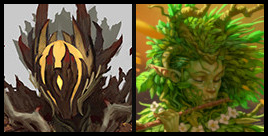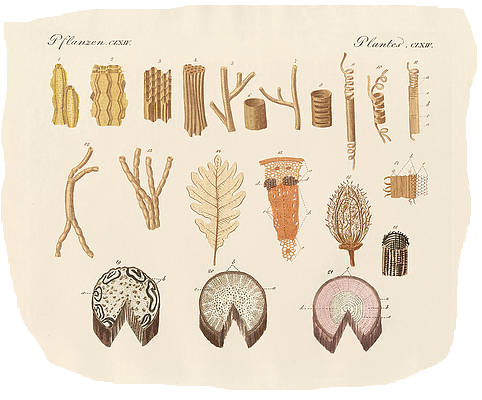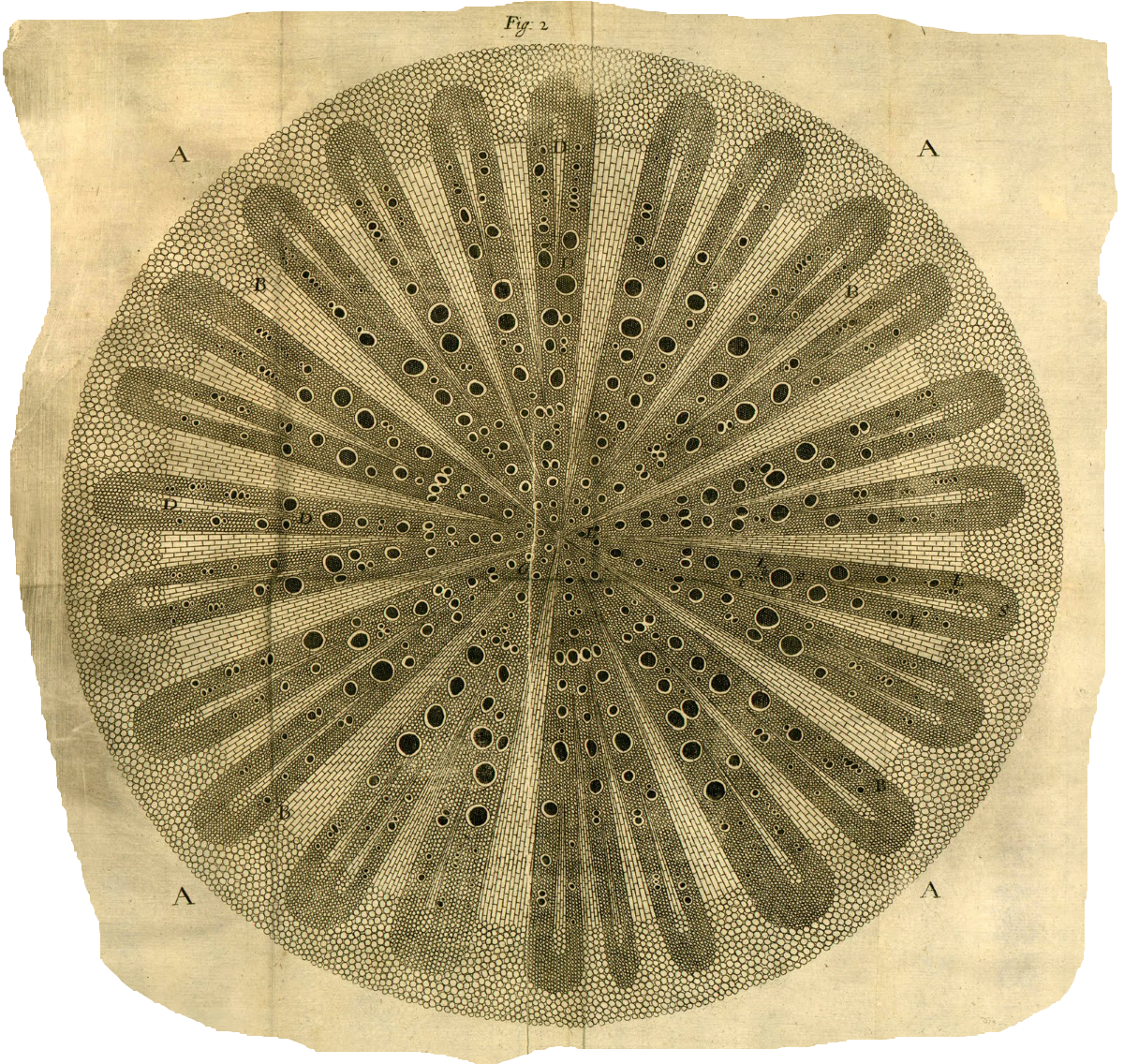Hedera
"Male" / "female" Hedera. | |
| Details | |
|---|---|
| Faction | The Realm of Arlandria |
| Lifespan | ??? |
| Population | Very Low |
| Average Height | 5'9" / 5'5" |
Grown of the woods and born to preserve.
The Hedera are, despite also being artificially sentient, generally considered much more "human" than the Empyrean. Their intellects are quite similar in level, but the Hederans are raised with human morals and ideals in mind, with a priority placed on spiritual and natural worship. They are additionally treated as equals, rather than superiors or inferiors. Of course, this doesn't speed up progress- Hederans are infamously very slow to act- but it certainly aids in making cautious and careful-minded decisions about your circumstances, a trait which they're known well for.
Appearance[edit]
The Hedera vary incredibly from case to case, almost on a whim- and in a way that can change from year to year. As they're totally plant-based, they can live to be ancient without showing it a great deal, and their visuals shift to match not just their personality throughout a given era, but also their environment. If nature suffers, the Hederans of that location will reflect that suffering and share in its pain should they remain for too long. Much like how Wildkin will pick a species of animal to reflect, Hederans can pick types of plants to encourage the growth of on their body, allowing them to grow shields of bark or flowers in their hair if so desired.
Culture[edit]
The culture of these dryadic creatures is heavily dependent on the first few years of their existence, back before Arlandria was born. The very first Hederans were taught humility by Felsen Skarn, and from there, their progeny were taught the same, and Skarn's followers were taught to not worship them. As a result, the general populace tends to do well to treat them as they would any other citizen, though there's often some excitement when one arrives. They do, after all, represent nature and the spirits, which all of Arlandria views quite highly.
Provided they do not reproduce normally by human standards, nor do they have proper genders, many wonder how new Hederans come to be. While it is true that many of them originate from nature magic, most are born asexually. See, while Hederans are biologically immortal, they cannot reproduce without "dying", persay. They elect to grow into a "Hederan Grove", which is a fancy term for a particularly lush area of the forest formed from the unfurling of the natural energy in a Hederan's body. It is there that a single- or, if the parent was particularly special, multiple- new Hederans are grown over the course of several years.
This doesn't mean they'll continue on infinitely, though. A slain Hederan cannot grow into a grove, as it's an act that takes preparation and cannot be performed on a whim. For this reason, both killing a Hederan and destroying a Hederan Grove is viewed as abhorrent, especially in Arlandrian society.
Yggdrasil, the World Tree[edit]
While Yggdrasil hasn't been around since the very beginning of the Hederan lifecycle, nor has it been there since the founding of Arlandria, it's nonetheless proven a welcome addition to the series of magical phenomena proceeding in the Weald. It towers over the rest of the forests and its growth shows no signs of slowing down. Others are more skeptical and doubt that the World Tree will continue to be as beneficial as it once was, especially going into the second instance of crisis... and the first that Yggdrasil has failed to prevent. Even so, none can doubt the value it provides.
Arlandria is suspected to have roots growing even beyond their parent continent that can be explored via the Hedera, who have since formed a deep bond with the spiritual tree. In a world where Empyreans exist and where things are constantly falling out of line, and for a country whose worries are unending, it only cements their behaviors and their mantra. The Hedera have shifted to grooming Yggdrasil rather than grooming the rest of the Weald, as the World Tree seems to nurse the rest of nature back to life simply by existing.
Whether it'll prove beneficial to humanity, though, remains to be seen.
Physiology[edit]
The history of Hedera anatomy is one of great controversy. Like much else of the species, for the longest time scarce little was understood of their biology concretely. Given their immortality, there were none to pass away from old age, which left only those fallen by violence or accident to be suitable candidates, given the absolute metamorphosis exhibited by the race after undergoing the change into a Grove. These were difficult as well, as the cultural reverence for their kind long tied the hands of anyone curious enough to try to further understand them and how they worked.
Following the climax of The First Convergence Crisis however, Arlandria was given the opportunity and motive to perform several dissections on mortally wounded Hedera who consented for scientific and medical purposes. This crucial information was guarded jealously for decades, but no information remains secret forever. A particularly daring espionage operation conducted by Isegrad in the late 980s succeeded in copying and recovering most if not all such secret documents and autopsy reports.
Respiratory System[edit]
While from first appearances the "lungs" of the Hedera appear to be identical to those possessed by Humelikes, on a structural level they are vastly different in composition and action. While most animal lungs inhale oxygen and exhale carbon dioxide, Hedera lungs appear to operate in reverse - intaking carbon dioxide and outputting oxygen. While in theory this would allow Hedera to operate in many environments dangerous to Humelikes - such as near fires - such has never been tested for obvious reasons.
Skeletal System[edit]
The skeleton of the Hedera is, remarkably, nearly identical to that of Humelikes and another vertebrate animals. Composed primarily of calcium, it forms the structural basis of both the musculature and other internal organs. This skeleton is far smaller in comparison to the Hedera body than other animal, but appears locked in a humanoid configuration. While Hedera bodies are capable of growing and twisting to their intentions, they appear to have hard limits dictated by their skeleton. Too large and the skeleton cannot support the rest. Too small and the bones get in the way - just like forms that differ too far from the Human norm.
Circulatory and Nervous System[edit]
Unlike every other vertebrate, the Cardiovascular and Nervous Systems of the Hedera appear completely inseparable and serves as a partial explanation for their remarkable ability to regenerate from nearly any damage to their body regardless of the location. A cluster of these "nodes" are kept safe in the skull and seemingly mirrors the function of any other brain. While it can take far more damage and recover than mammalian brains, massive trauma to it remains lethal.
Many of the functions of an animal's heart appear to be performed by the Amber situated at the core of the Hedera's chest, as it pumps Ichor, a sap-like analogue to blood, throughout the body. Strangely enough, it seems to perform this without beating as any other heart would. The exact method it manages to do this remains unknown, but many speculate a purely magical origin.
Further nodes snake down the Skeletal System, routed primarily through the spine, and serve the dual purpose of transferring Hederan Ichor around the body and controlling it in tandem. This redundancy of functions combined with the unique Muscular System provides incredible capacity to recover.
Muscular System[edit]
Ever-growing, the Hederan Musculature is an example of how the Hedera can be functionally immortal. Continually regenerating even at rest, excess biomass has to be intentionally shed or otherwise manipulated to change appearance. This continual refreshing appears to keep the body in peak physical condition no matter how old the individual in question.
Each individual "muscle" also shows great capacity to twist and reform over time, further permitting these relatively extreme changes to the body over the course of weeks or months. This flexibility allows the outermost layers of muscle to appear in different fashions. Some keep it supple and much like human flesh. Others prefer the opposite and cover themselves in a durable yet flexible bark.
Digestive System[edit]
Simply put, the above capabilities of the Hedera do not come freely. They are remarkably inefficient compared to Humelikes in daily needs and manifests as an abnormally strong hunger. While generally offset with photosynthesis and absorbing nutrients from the soil and nearby plants by interlacing their Circulatory System, they still exhibit above-average appetites. While the average adult Humelike requires between 2000-2500 calories a day, a Hedera requires upwards of 2500-3500 calories a day in addition to passive feeding.
This number can skyrocket if deprived of daylight for an extended period of time.
Reproductive System[edit]
As expected, the Hedera do not appear to bear anything resembling a Reproductive System while in their humanoid stage of development.
Additional Organs[edit]
Beyond the noted exceptions above, much of the Hedera body has analogous organs that may differ in appearance or precise location, but perform nearly identical purposes as those found in Humelikes.
Notable Hedera[edit]
- This could be you!
Trivia[edit]
- Hederans technically existed at the end of the Beta, for a brief period of time.



